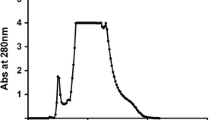Abstract
Agrocybe aegerita peroxidase/peroxygenase (AaP) is an extracellular fungal biocatalyst that selectively hydroxylates the aromatic ring of naphthalene. Under alkaline conditions, the reaction proceeds via the formation of an intermediary product with a molecular mass of 144 and a characteristic UV absorption spectrum (A max 210, 267, and 303 nm). The compound was semistable at pH 9 but spontaneously hydrolyzed under acidic conditions (pH <7) into 1-naphthol as major product and traces of 2-naphthol. Based on these findings and literature data, we propose naphthalene 1,2-oxide as the primary product of AaP-catalyzed oxygenation of naphthalene. Using 18O-labeled hydrogen peroxide, the origin of the oxygen atom transferred to naphthalene was proved to be the peroxide that acts both as oxidant (primary electron acceptor) and oxygen source.



Similar content being viewed by others
References
Berti G (1973) Stereochemical aspects of the synthesis of 1,2-epoxides. In: Allinger NL, Eliel EL (eds) Topics in stereochemistry, volume 7. Wiley, New York, pp 93–251
Blanke SR, Martinis SA, Sligar SG, Hager LP, Rux JJ, Dawson JH (1996) Probing the heme iron coordination structure of alkaline chloroperoxidase. Biochemistry 35:14537–14543
Boyd DR, Sharma ND (1996) The changing face of arene oxide–oxepine chemistry. Chem Soc Rev 25:289–296
Boyd DR, Sharma ND, Agarwal SK, Balani K, Dunlop R, Gadaginamath GS, O'Kane GA, Jennings WB, Yagi H, Jerina DM (1987) Preparation of oxepines during direct chemical synthesis and facile oxygen walk reactions of arene oxides: theoretical predictions and experimental evidence. Chem Soc Chem Commun 1987:1633–1635
Brown CM, Reisfeld B, Mayeno AN (2008) Cytochromes P450: a structure-based summary of biotransformations using representative substrates. Drug Metab Rev 40:1–100
Dau HA, Ullrich R, Benndorf D, Svatos A, Muck A, Hofrichter M (2007) The coprophilous mushroom Coprinus radians secretes a haloperoxidase that catalyzes aromatic peroxygenation. Appl Environ Microbiol 73:5477–5485
Hofrichter M, Ullrich R (2006) Heme-thiolate haloperoxidases: versatile biocatalysts with biotechnological and environmental significance. Appl Microbiol Biotechnol 71:276–288
Jerina DM, Daly JW, Jeffrey AM, Gibson DT (1971) Cis-1,2-dihydroxy-1,2-dihydronaphthalene: a bacterial metabolite from naphthalene. Arch Biochem Biophys 142:394–396
Jerina DM, Daly JW, Witkop B, Zaltzman-Nirenberg P, Udenfriend S (1970) 1,2-naphthalene oxide as an intermediate in the microsomal hydroxylation of naphthalene. Biochemistry 9:147–156
Kasparek GJ, Bruice TC (1972) The mechanism of the aromatization of arene oxides. J Am Chem Soc 94:198–202
Kluge M, Ullrich R, Scheibner K, Hofrichter M (2007) Spectrophotometric assay for detection of aromatic hydroxylation catalyzed by a fungal peroxygenase. Appl Microbiol Biotechnol 75:1473–1478
Maier G (1967) Das Norcaradien-Problem. Angew Chem 79:446–458
Omura T (2005) Heme-thiolate proteins. Biochem Biophys Res Commun 338:404–409
Uhart M, Piscera JM, Albertó E (2008) Utilization of new naturally occurring strains and supplementation to improve the biological efficiency of the edible mushroom Agrocybe cylindracea. J Ind Microbiol Biotechnol 35:595–602
Ullrich R, Nüske J, Scheibner K, Spantzel J, Hofrichter M (2004) Novel haloperoxidase from the agaric basidiomycete Agrocybe aegerita oxidizes aryl alcohols and aldehydes. Appl Environ Microbiol 70:4575–4581
Ullrich R, Hofrichter M (2005) The haloperoxidase of the agaric fungus Agrocybe aegerita hydroxylates toluene and naphthalene. FEBS Lett 579:6247–6250
Ullrich R, Hofrichter M (2007) Enzymatic hydroxylation of aromatic compounds. Cell Mol Life Sci 64:271–293
Vogel E, Klärner F (1968) 1,2-Naphthalene oxide. Angew Chem Internat Edit 7:374–375
Acknowledgement
The authors would like to thank the following institutions and organizations for financial support: European Union (integrated project BIORENEW), the German Ministry of Education and Research (BMBF, project 0313433D), and the German Environmental Foundation (DBU, project 13225-32).
Author information
Authors and Affiliations
Corresponding author
Rights and permissions
About this article
Cite this article
Kluge, M., Ullrich, R., Dolge, C. et al. Hydroxylation of naphthalene by aromatic peroxygenase from Agrocybe aegerita proceeds via oxygen transfer from H2O2 and intermediary epoxidation. Appl Microbiol Biotechnol 81, 1071–1076 (2009). https://doi.org/10.1007/s00253-008-1704-y
Received:
Revised:
Accepted:
Published:
Issue Date:
DOI: https://doi.org/10.1007/s00253-008-1704-y




